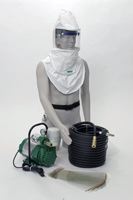 |
 |
| MSDS Topics |
Free Sites | FAQ's | Regulations | Glossary | Software | Suppliers |
| Books | Forum | Poll | Fun stuff | Quiz | Store | |
| MSDS and safety supplies | Search ALL our MSDS info | |||||
 | |||
 |
 |
 |
|
| Title: 12/04/1989 - Carcinogen labeling requirements of the Hazard Communication Standard. | |
| Record Type: Interpretation | Standard Number: 1910.1200(f) |
December 4, 1989
Ms. Linda M. Loreth
Environmental, Health and Safety Manager
A.W. Chesterton Company
225 Fallon Road
Middlesex Industrial Park
Stoneham, Massachusetts 02180-2999
Dear Ms. Loreth:
|
This is in response to your letter of October 26 to the Occupational Safety and Health Administration (OSHA) requesting an interpretation of the carcinogen labeling requirements of the Hazard Communication Standard (HCS), 29 CFR 1910.1200. The HCS requires hazard determinations to be performed for those chemicals to which employees may be actually or potentially exposed under normal conditions of use or in a foreseeable emergency at the workplace. In your letter, you question the carcinogen labeling requirement for nickel powder which is part of a "mixture which does not separate or in itself become air-borne under normal use or perhaps in the case of an aerosol, and the mixture, because of other ingredients, does not spray respirable size particles." On August 8, 1988, OSHA published in the Federal Register a Notice of Proposed Rulemaking proposing various modifications to the HCS. In this publication, on page 29831, the Agency discusses the applicability of the rule to materials chemically bound in solids or liquid formulations in such a manner that they cannot be released under normal conditions of use or in a foreseeable emergency. A copy of the referenced page is enclosed. I encourage you to review the Agency's position on the applicability of the rule under these conditions as presented in the Proposed HCS Rule. |  Spray painters should have a complete supplied air respirator system like this one from Safety Emporium. |
Under the HCS, it is the responsibility of the chemical manufacturer to determine the hazard of the chemicals he or she produces if they "could be released in concentrations" that "could present a health hazard to employees" (see 1910.1200(d)(5)(iv)). The procedures used by the chemical manufacturer in his or her hazard determination must additionally be in written form and be made available to an OSHA compliance officer upon request.
Furthermore, the HCS defines employee exposure as including ingestion, skin contact and absorption, in addition to inhalation. The HCS's definition of "exposure" includes potential exposure, defined as accidental or possible exposure. In both the conditions described in your letter, the potential for exposure via routes of entry other than inhalation exist. The hazard to the workers who handle the nickel powder may not just be "via inhalation" as you indicate in your letter. Carcinogen notification on the label may be appropriate, therefore, if exposure could occur, either routinely or accidentally, via any of the various routes of entry.
Again, hazard determinations are always the responsibility of the chemical manufacturer. OSHA does not "exempt" specific manufacturers from the responsibilities of the Hazard Communication Standard. It is up to the chemical manufacturer to anticipate the downstream uses and potential exposure scenarios of the hazardous chemicals he produces and label his products accordingly. If a hazardous chemical could be released in such a way as to result in employee exposure, employees have the right to be informed of this. If there is not the potential for exposure, the chemical is not subject to the rule.
I hope this helps clarify your concerns in this regard. If you have further questions, you may want to contact Mr. Fred Malaby, OSHA's Regional Hazard Communication Coordinator in OSHA's Boston Regional Office at (617) 565-7164. Mr. Malaby would be pleased to assist you in any further questions you may have on the intent and implementation of the Hazard Communication rule.
Sincerely,
Thomas J. Shepich, Director
Directorate of Compliance Programs
The official, public domain, OSHA version of this document is available at http://www.osha.gov/pls/oshaweb/owadisp.show_document?p_table=INTERPRETATIONS&p_id=19884&p_text_version=FALSE